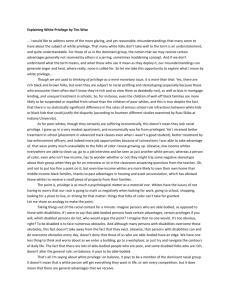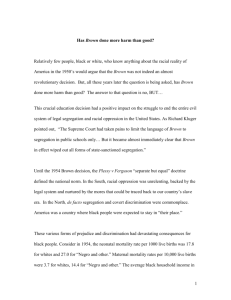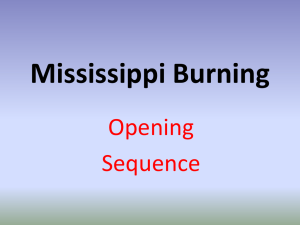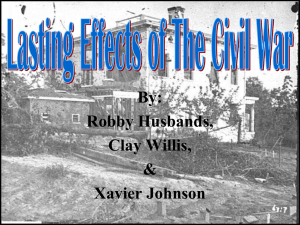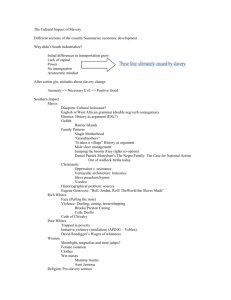Psychological Inquiry Understanding White Identity Politics Will Be
advertisement
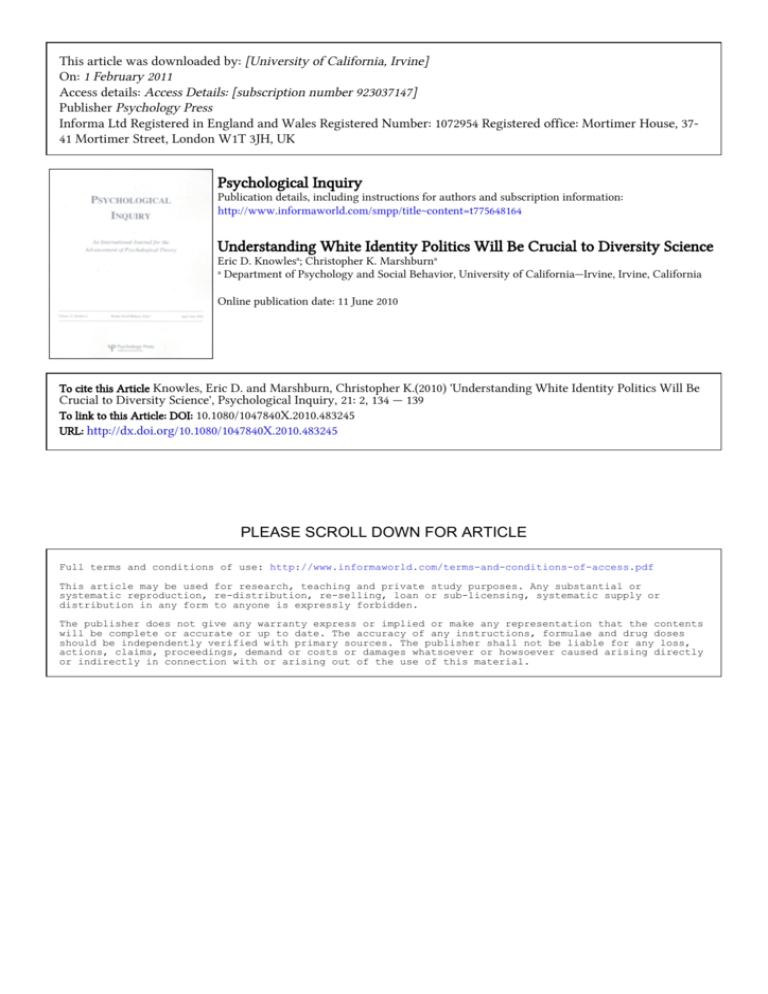
This article was downloaded by: [University of California, Irvine] On: 1 February 2011 Access details: Access Details: [subscription number 923037147] Publisher Psychology Press Informa Ltd Registered in England and Wales Registered Number: 1072954 Registered office: Mortimer House, 3741 Mortimer Street, London W1T 3JH, UK Psychological Inquiry Publication details, including instructions for authors and subscription information: http://www.informaworld.com/smpp/title~content=t775648164 Understanding White Identity Politics Will Be Crucial to Diversity Science Eric D. Knowlesa; Christopher K. Marshburna a Department of Psychology and Social Behavior, University of California—Irvine, Irvine, California Online publication date: 11 June 2010 To cite this Article Knowles, Eric D. and Marshburn, Christopher K.(2010) 'Understanding White Identity Politics Will Be Crucial to Diversity Science', Psychological Inquiry, 21: 2, 134 — 139 To link to this Article: DOI: 10.1080/1047840X.2010.483245 URL: http://dx.doi.org/10.1080/1047840X.2010.483245 PLEASE SCROLL DOWN FOR ARTICLE Full terms and conditions of use: http://www.informaworld.com/terms-and-conditions-of-access.pdf This article may be used for research, teaching and private study purposes. Any substantial or systematic reproduction, re-distribution, re-selling, loan or sub-licensing, systematic supply or distribution in any form to anyone is expressly forbidden. The publisher does not give any warranty express or implied or make any representation that the contents will be complete or accurate or up to date. The accuracy of any instructions, formulae and drug doses should be independently verified with primary sources. The publisher shall not be liable for any loss, actions, claims, proceedings, demand or costs or damages whatsoever or howsoever caused arising directly or indirectly in connection with or arising out of the use of this material. Psychological Inquiry, 21: 134–139, 2010 C Taylor & Francis Group, LLC Copyright ISSN: 1047-840X print / 1532-7965 online DOI: 10.1080/1047840X.2010.483245 Understanding White Identity Politics Will Be Crucial to Diversity Science Eric D. Knowles and Christopher K. Marshburn Downloaded By: [University of California, Irvine] At: 01:05 1 February 2011 Department of Psychology and Social Behavior, University of California—Irvine, Irvine, California In her target article, Victoria Plaut (this issue) makes the case for the inception of a “diversity science” for the 21st century. This science would dedicate itself to understanding how individuals from diverse backgrounds can coexist productively, harmoniously, and in a manner conducive to individual well-being. At first glance, diversity science might appear to duplicate the goals of traditional research into intergroup relations. However, such an interpretation does not do justice to Plaut’s important proposal. Unlike most social-psychological treatments of prejudice, stereotyping, and discrimination, diversity science treats intergroup relations as sociocultural phenomena in which “cultural and structural realities (i.e., cultural beliefs and social positioning)” shape the manner in which groups relate to one another (Plaut, this issue). Diversity science’s emphasis on sociocultural processes sets up another crucial (and rather “meta”) theme: that to understand diversity, one must understand how people understand diversity. As such, diversity science seeks to know how culturally shared and structurally shaped models of “what difference is and whether and how it matters” determine intergroup behavior (Plaut, this issue, p. 93). We fully support Plaut’s broad and synthetic approach to understanding diversity, and in this commentary we seek to expand on one of the issues she identifies as essential to diversity science: Whites as racial actors. system (e.g., Plant & Peruche, 2005), the existence of White “ethnic enclaves” (e.g., Sidanius, van Laar, Levin, & Sinclair, 2004), and the possible existence of shared White cultural practices (e.g., Perry, 2002). Yet, in presenting us with a character who claims to lack firsthand, intuitive access to his racial identity, Colbert’s primary purpose is to lampoon Whites’ habit of denying racial self-consciousness—of pleading unawareness of Whiteness and the privileges it confers. The joke’s subtext, of course, is that this claimed unawareness is naı̈ve at best, and disingenuous at worst; Whites, to use Plaut’s term, are “racial actors” just like anyone else (Plaut, this issue). Social groups, including racial and ethnic ones, are often said to engage in “identity politics,” the formation of political beliefs and alliances intended to further the interests of the group.1 The notion that minority groups engage in identity politics would strike most Whites as almost trivially true. The notion that their own racial group engages in identity politics, however, is likely to sound strange—even oxymoronic—to Whites. Racial identity politics requires racial self-consciousness; thus, to the extent that a White person possesses (or at least professes) the deep race-neutrality of Stephen Colbert’s alter ego, White identity politics becomes a contradiction in terms. Consistent with what historian George Lipsitz (1998) has called “the possessive investment in Whiteness” (p. 2), we argue that Whites routinely engage in identity politics, acting in ways that further their interests as members of the dominant racial group. In so doing, Whites betray the fact that their experience of the world is informed by their awareness of and concern for their fates as White people. White Identity Politics Television satirist Stephen Colbert, of Comedy Central’s The Colbert Report, has an ongoing joke in which he describes himself as racially color-blind. Not only is he incapable of discerning others’ race, but he cannot see his own. However, based on secondhand information and his own powers of deduction, he thinks he is probably White. Thus, he says, “People tell me I’m White and I believe them, because police officers call me ‘sir”’—or, in other incarnations of the joke, “because I belong to an all-White country club” and “because I own a lot of Jimmy Buffett albums” (Colbert, 2005). Colbert is succinctly spotlighting several phenomena of interest to social scientists, including pro-White favoritism in the criminal justice White Identity The notion that Whites must lack racial selfawareness is not entirely without logic. As many sociologists and ethnographers (e.g., Bonilla-Silva, 2003; Flagg, 1993; Frankenberg, 1993; McIntosh, 1988; 1 We use the terms politics and political in the sense of attitudes and behavior chosen to further one’s access to status, wealth, relative well-being, or any other form of material or social capital. This definition includes, but is broader than, individuals’ attitudes and behavior vis-à-vis public policy and elections. 134 Downloaded By: [University of California, Irvine] At: 01:05 1 February 2011 COMMENTARIES McIntyre, 1997; Perry, 2002) have observed, Whites’ hegemonic position in the social order “normalizes” Whiteness in ways that make it elusive to those who have it. Whites’ numerical advantage in the United States2 further reduces the perceptual salience of White racial identity (Knowles & Peng, 2005; McGuire, McGuire, Child, & Fujioka, 1978; Perry, 2002). But despite Whites’ unrivaled ability to “blend into the woodwork,” many members of the dominant racial group incorporate the White category into their self-concepts (Knowles & Peng, 2005). Squaring this fact with Whites’ explicit denial of racial self-consciousness is not difficult when White identity is measured at the nonconscious level, as Knowles and Peng (2005) did using their White Identity Centrality Implicit Association Test. Such White racial self-consciousness, even if implicit, makes White identity politics possible. Whites’ Pursuit of Their Material Interests The extent to which perceived material interests shape Whites’ attitudes and behavior is the subject of vigorous debate. Some scholars (e.g., Blumer, 1958; Bobo, 1998) contend that White opposition to redistributive social policies, such as affirmative action and school busing, reflects fear that such policies threaten the dominant group’s socioeconomic position. Other scholars (e.g., Sears & Funk, 1990; Sears, Lau, Tyler, & Allen, 1980) contend that Whites’ policy positions are primarily outgroup focused, reflecting animus against racial minorities. Although the role of racial animus cannot be ignored, we believe that recent work validates the role of material interests in shaping Whites’ intergroup attitudes and behavior. In an illustrative study, Lowery, Unzueta, Knowles, and Goff (2006) presented Whites with affirmative action policies varying in “strength” (cf. Bobocel, Son Hing, Davey, Stanley, & Zanna, 1998). Perhaps not surprisingly, Whites opposed strong policies (e.g., a “minimum qualifications” policy in which a minority applicant could be hired over a better qualified White applicant) more than weak policies (e.g., outreach efforts). Strong policies were also seen as helping minorities—and harming Whites—more than weak ones. Crucially, however, only the degree of anticipated harm to Whites, and not the expected benefit to minorities, mediated the relationship between policy strength and support for affirmative action. In other words, Whites’ attitudes toward affirmative action were primarily ingroup focused. Central to Plaut’s sociocultural approach is the idea that intergroup outcomes depend on the meanings we attach to “diversity”—that is, our ideas about the nature of group differences and the implications of these differences. Individuals’ models of diversity, 2 Which, according to the U.S. Census Bureau, will shrink to a plurality by the year 2042. in turn, must be seen as developing in the context of social-structural relations between groups. Thus, one of Whites’ most effective identity-political maneuvers is the selection of ideologies, including diversity models, that serve dominant-group interests. Colorblindness—the notion that racial differences are only skin deep and should be ignored—is an example of just such an ideology. As Plaut (this issue) observes, the adoption of color-blind ideology can negatively affect Whites’ racial attitudes (Forman, 2004; Richeson & Nussbaum, 2004; Wolsko, Park, Judd, & Wittenbrink, 2000) and, when it becomes the norm in business organizations, alienate minority workers (Plaut, Thomas, & Goren, 2009). Evidence suggests that Whites strategically embrace color-blind ideology to protect their advantaged position in the intergroup hierarchy. Knowles, Lowery, Hogan, and Chow (2009) theorized that color-blindness comes in “hierarchy-attenuating” and “hierarchy-enhancing” forms (Sidanius, Levin, Federico, & Pratto, 2001). As a principle of distributive justice, color-blindness expresses the desire to reduce intergroup inequity; as a principle of procedural justice, however, color-blindness may entrench inequity by proscribing the race-conscious policies (e.g., affirmative action) most likely to reduce them. Knowles and colleagues (2009) found that Whites who place high value on their position in the social order—namely, those high in Social Dominance Orientation (SDO; Pratto, Sidanius, Stallworth, & Malle, 1994)—tended to reject color-blindness in its distributive form. When induced to feel insecure about the stability of the intergroup hierarchy, however, high-SDO Whites strongly embraced color-blindness in its procedural, hierarchyenhancing form. This is White identity politics at a high level: by actively reconstruing and embracing a popular philosophy with which they usually disagree, Whites buttress existing patterns of inequality while staying well within the bounds of “civilized” ideological discourse (Knowles et al., 2009). Color-blindness represents an especially pernicious ideology in the present sociopolitical environment. Having just elected their first Black president, many Americans may be tempted to believe that a postracial era has begun. Postelection postracialism is, of course, a chimera: Not only was prejudice a significant factor in many voters’ decision to oppose Barack Obama (Greenwald, Smith, Sriram, Bar-Anan, & Nosek, 2009; Knowles, Lowery, & Schaumberg, 2010; Payne et al., 2009), but anti-Black bias continues to shape reactions to the president and his policies (Knowles et al., 2010). But does postracialism function as a legitimizing ideology? Knowles, Lowery, and Schaumberg (2009) found evidence that it does. In the days before the 2008 general election, these researchers administered a measure of antiegalitarianism (i.e., SDO) to a mostly White sample of eligible voters. After the 135 Downloaded By: [University of California, Irvine] At: 01:05 1 February 2011 COMMENTARIES election, participants reported their vote, as well as their beliefs about the implications of Obama’s victory. For many participants, antiegalitarianism was associated with a tendency not to vote for Obama. For one subset of participants, however, levels of SDO were positively correlated with the likelihood of voting for Obama—namely, those who believe that his victory indicates the inception of a postracial America. The authors interpreted this pattern in terms of postracialism’s appeal as a hierarchy-enhancing ideology: In what would be a painful irony, individuals heavily invested in the racial status quo may have voted for Obama in order to underwrite the inequity-entrenching claim that race no longer matters.3 If color-blindness and postracialism are dangerous, then what of multiculturalism? Is it the antidote to entrenchment of inequality and alienation of minorities? Research by Plaut and others (e.g., González, Verkuyten, Weesie, & Poppe, 2008; Plaut, 2002; Plaut et al., 2009; Richeson & Nussbaum, 2004; Verkuyten, 2009) suggests that multicultural ideology improves majority attitudes and minority well-being. As she cautions, however, multicultural ideology might have the unwanted side effect of essentializing group differences and encouraging the stereotyping and marginalization of minorities. New research by Gutiérrez and Unzueta (in press) bears out this possibility. These researchers primed individuals with multicultural or color-blind ideology and examined subsequent liking for stereotypic versus counterstereotypic minority targets. Whereas participants exposed to the color-blind prime preferred targets that violated expectations (e.g., an African American who likes surfing and country dancing), individuals exposed to the multicultural prime preferred stereotype-consistent targets (e.g., an African American who likes basketball and hip-hop dancing). These findings may indicate that multiculturalism can foster the expectation that minority individuals will exemplify stereotypic notions of the “typical” group member. Knowles and colleagues’ (Knowles et al., 2009) findings with respect to color-blindness highlight another possible danger. This work suggests that sociopolitical ideologies are eminently malleable and can be thus used to further diametrically opposed intergroup goals. If this is so, then Whites may find in multiculturalism a powerful legitimizing ideology. If construed in a way that encourages an essentialistic, Balkanized conception of race, multiculturalism could become another tool of White identity politics. Thus, although multiculturalism is a promising diversity model (Plaut, 3 It is not that antiegalitarian participants who endorse postracialism somehow saw the light and embraced the virtues of Barack Obama. These same individuals were especially likely to blame him, rather than chief justice John Roberts, for muffing the oath of office on January 20, 2009 (see “Obama Retakes Oath,” 2009). 136 this issue), care must be taken to guard against its potential side effects and hierarchy-enhancing uses. Whites’ Pursuit of Their Psychological Interests We have argued that Whites engage in identity politics that serve their perceived material interests as members of the dominant group. Material privilege, however, is not the only thing at stake in a hierarchical society. At least as important are individuals’ psychological interests, or global feelings of self-competence, self-regard, and self-worth. With few exceptions, we all want to feel like good people—and this is where things get dicey for Whites. One might expect that benefitting from unearned privilege, or even just belonging to a group with an oppressive history, would undermine Whites’ psychological interests. Indeed, thinking about one’s group-based privileges or about the historical wrongs committed by the group can cause feelings of collective guilt and reduce ingroup-esteem (Branscombe, 1998; Iyer, Leach, & Crosby, 2003; Powell, Branscombe, & Schmitt, 2005). Worse yet, unearned advantage creates an attributional predicament for Whites, as it threatens to “discount” (Kelley, 1973) internal attributions for their successes and “augment” (Morris & Larrick, 1995) internal attributions for their failures (Lowery & Wout, in press). Given these pitfalls of Whiteness, one might expect the dominant group to be in a collective funk. Why aren’t they? We argue that Whites defend their psychological interests (e.g., feelings of self-adequacy) against the threat of privilege by engaging in three identity-political maneuvers. Denial. Whites’ first line of defense against the threat of privilege is simply to deny its existence (Leach, Snider, & Iyer, 2002). Lowery, Knowles, and Unzueta (2007) examined the motivated denial of privilege by manipulating Whites’ need to bolster a positive sense of self and examining subsequent acknowledgement of White privilege. The need to self-enhance was varied by having participants complete a bogus intelligence test, after which they were randomly assigned to receive one of two scores—the 89th percentile or the 11th percentile. The researchers found that White participants whose competence had been called into question subsequently acknowledged White privilege to a lesser extent that those whose competence had been affirmed. Of importance, this effect held only for individuals scoring high on a measure of White identity, thus supporting the contention that Whites deny the existence of ingroup privilege to shield the self from threat. Further evidence for the denial strategy comes from work examining White men and women’s beliefs about the nature of affirmative action (Unzueta, Gutiérrez, & Ghavami, 2010; Unzueta, Lowery, & Knowles, 2008). COMMENTARIES Downloaded By: [University of California, Irvine] At: 01:05 1 February 2011 This research tested whether Whites derive a psychological benefit from the (incorrect) belief that affirmative action policies commonly employ aggressive minority quotas—a belief tied to the notion that minorities have actually achieved advantage over Whites. Indeed, Unzueta and colleagues (2008) found that the belief in affirmative action quotas—whether measured or manipulated—buffered Whites against self-image threat in the form of bogus negative feedback on an intelligence test. Seeing themselves to be victims of stringent minority quotas, participants came to believe that Whiteness confers no advantage—and even, perhaps, imparts disadvantage. Disidentification. A second line of defense against the psychological threat posed by ingroup privilege is to distance the self-concept from the offending social identity—that is, to disidentify. By doing so, Whites can tolerate the existence of ingroup privilege because they do not consider their Whiteness to be an important or impactful attribute of the self. Chow, Lowery, and Knowles (2008) found evidence for this strategy. In this study, the researchers framed intergroup inequity in a manner that highlighted either Black disadvantage (i.e., “The SAT is biased against Blacks”) or White privilege (“The SAT is biased in favor of Whites”). As expected, Whites for whom ingroup privilege was made salient scored lower on a measure of White identity than did those who focused on outgroup disadvantage. Thus, Whites may render White privilege irrelevant to the self by simply coming to see themselves as less “White.” Dismantling. A final—and, in our view, more desirable—strategy through which Whites can alleviate the threat of privilege is to promote the “dismantling” of inequality (Leach et al., 2002). It may be that Whites can accomplish this by supporting redistributive social policies, such as affirmative action. Lowery, Chow, Knowles, and Unzueta (n.d.) presented evidence for just this process. These researchers manipulated how the effects of a fictitious firm’s affirmative action policy were framed—either as helping Blacks or hurting Whites. In addition, the inequity motivating the policy was described as either disadvantaging Blacks or advantaging Whites. In the Black disadvantage condition, Whites exhibited less support for a policy described as hurting the ingroup than one that framed as helping the outgroup (thus replicating Lowery et al., 2006). Crucially, however, the pattern was reversed in the White advantage condition, such that Whites were more supportive of an ingroup-harming than an outgroup-helping policy. It appears that Whites’ concern for their psychological interests drove this effect: Whites supported an ingroup-harming policy to the extent that the advantage frame reduced their private regard for the ingroup (Luhtanen & Crocker, 1992). This provides striking evidence that Whites, to dispel the threat of privilege, are sometimes willing to embrace policies that dismantle privilege by reducing the White ingroup’s dominance. Conclusions Victoria Plaut (this issue) makes the case for a diversity science that conceptualizes intergroup relations as sociocultural phenomena—that is, as products of the interplay between sociocultural forces and individual psychology. We find her case compelling, and in this comment have tried to flesh out how members of the dominant racial group (Whites) fit into this framework. In closing, it is worth highlighting three aspects of our account that dovetail especially well with Plaut’s approach. First, we agree with Plaut that Whites are racial actors and must be understood as such. Second, we have made the structural argument that Whites’ cognizance of their race and its dominant position in the social order inexorably shapes their intergroup attitudes and behavior. Finally, we have articulated ways in which Whites tap into broadly appealing cultural themes—such as color-blindness and multiculturalism—while construing them in ways that satisfy their motivations vis-à-vis the intergroup hierarchy. By making these cultural meanings their own, members of the dominant group who wish to buttress their group’s dominant social position can do so while staying within the bounds of culturally appropriate discourse. This, in turn, makes White identity politics more effective—even if they are rarely acknowledged. Note Address correspondence to Eric D. Knowles, Department of Psychology and Social Behavior, University of California—Irvine, 4313 Social and Behavior Sciences, Irvine, CA 92697. E-mail: eknowles@ uci.edu References Blumer, H. (1958). Race prejudice as a sense of group position. Pacific Sociological Review, 1, 3–7. Bobo, L. (1998). Race, interests, and beliefs about affirmative action. American Behavioral Scientist, 41, 985–1003. Bobocel, D. R., Son Hing, L. S., Davey, L. M., Stanley, D. J., & Zanna, M. P. (1998). Justice-based opposition to social policies: Is it genuine? Journal of Personality and Social Psychology, 75, 653–669. Bonilla-Silva, E. (2003). Racism without racists: Color-blind racism and the persistence of racial inequality in the United States. Lanham, MD: Rowman and Littlefield. Branscombe, N. R. (1998). Thinking about one’s gender group’s privileges or disadvantages: Consequences for well-being in women and men. British Journal of Social Psychology, 37, 167–184. 137 Downloaded By: [University of California, Irvine] At: 01:05 1 February 2011 COMMENTARIES Chow, R. M., Lowery, B. S., & Knowles, E. D. (2008). The two faces of dominance: The differential effect of ingroup superiority and outgroup inferiority on dominant-group identity and group esteem. Journal of Experimental Social Psychology, 44, 1073– 1081. doi:10.1016/j.jesp.2007.11.002 Colbert, S. (Producer). (2005). The Colbert report. New York: Comedy Central. Flagg, B. J. (1993). “Was blind, but now I see”: White race consciousness and the requirement of discriminatory intent. Michigan Law Review, 91, 953–1017. Forman, T. (2004). Color-blind racism and racial indifference: The role of racial apathy in facilitating enduring inequalities. In M. Krysan & A. E. Lewis (Eds.), The changing terrain of race and ethnicity (pp. 43–66). New York: Russell Sage Foundation. Frankenberg, R. (1993). White women, race matters: The social construction of whiteness. Minneapolis: University of Minnesota Press. González, K. V., Verkuyten, M., Weesie, J., & Poppe, E. (2008). Prejudice towards Muslims in The Netherlands: Testing integrated threat theory. British Journal of Social Psychology, 47, 667–685. Greenwald, A. G., Smith, C. T., Sriram, N., Bar-Anan, Y., & Nosek, B. A. (2009). Implicit race attitudes predicted vote in the 2008 U.S. presidential election. Analyses of Social Issues and Public Policy, 9, 241–253. Gutiérrez, A. S., & Unzueta, M. M. (in press). The effect of interethnic ideologies on the perceptions of stereotypic vs. counterstereotypic minority targets. Journal of Experimental Social Psychology. Iyer, A., Leach, C. W., & Crosby, F. J. (2003). White guilt and racial compensation: The benefits and limits of self-focus. Personality and Social Psychology Bulletin, 29, 117–129. Kelley, H. H. (1973). The processes of causal attribution. American Psychologist, 28, 107–128. Knowles, E. D., Lowery, B. S., Hogan, C. M., & Chow, R. M. (2009). On the malleability of ideology: Motivated construals of color blindness. Journal of Personality and Social Psychology, 96, 857–869. Knowles, E. D., Lowery, B. S., & Schaumberg, R. L. (2009). Antiegalitarians for Obama? Group-dominance motivation and the Obama vote. Journal of Experimental Social Psychology, 45, 965–969. Knowles, E. D., Lowery, B. S., & Schaumberg, R. L. (2010). Racial prejudice predicts opposition to Obama and his health care plan. Journal of Experimental Social Psychology, 46, 420–423. Knowles, E. D., & Peng, K. (2005). White selves: Conceptualizing and measuring a dominant-group identity. Journal of Personality and Social Psychology, 89, 223–241. Leach, C. W., Snider, N., & Iyer, A. (2002). “Poisoning the consciences of the fortunate”: The experience of relative advantage and support for social equality. In I. Walker (Ed.), Relative deprivation: Specification, development, and integration (pp. 136–163). New York: Cambridge University Press. Lipsitz, G. (1998). The possessive investment in Whiteness: How White people profit from identity politics. Philadelphia: Temple University Press. Lowery, B. S., Chow, R. M., Knowles, E. D., & Unzueta, M. M. (n.d.). Paying for positive group-image: How perceptions of inequity affect responses to redistributive social policies. Unpublished manuscript, Stanford University, Stanford, CA. Lowery, B. S., Knowles, E. D., & Unzueta, M. M. (2007). Framing inequality safely: Whites’ motivated perceptions of racial privilege. Personality and Social Psychology Bulletin, 33, 1237– 1250. Lowery, B. S., Unzueta, M. M., Knowles, E. D., & Goff, P. A. (2006). Concern for the ingroup and opposition to affirmative action. Journal of Personality and Social Psychology, 90, 961–974. 138 Lowery, B. S., & Wout, D. A. (in press). When inequality matters: The effect of inequality frames on academic engagement. Journal of Personality and Social Psychology. Luhtanen, R., & Crocker, J. (1992). A collective self-esteem scale: Self-evaluation of one’s social identity. Personality and Social Psychology Bulletin, 18, 302–318. McGuire, W. J., McGuire, C. V., Child, P., & Fujioka, T. (1978). Salience of ethnicity in the spontaneous self-concept as a function of one’s ethnic distinctiveness in the social environment. Journal of Personality and Social Psychology, 36, 511– 520. McIntosh, P. (1988). White privilege and male privilege: A personal account of coming to see correspondences through work in Women’s Studies. Wellesley, MA: Wellesley Centers for Women. McIntyre, A. (1997). Making meaning of whiteness: Exploring racial identity with white teachers. Albany: State University of New York Press. Morris, M. W., & Larrick, R. P. (1995). When one cause casts doubt on another: A normative analysis of discounting in causal attribution. Psychological Review, 102, 331–355. Obama retakes oath of office after flub. (2009, January 22). Retrieved from http://www.msnbc.msn.com/id/28780417/ Payne, B. K., Krosnick, J. A., Pasek, J., Lelkes, Y., Akhtar, O., & Tompson, T. (2009). Implicit and explicit prejudice in the 2008 American presidential election. Journal of Experimental Social Psychology, 46, 367–374. Perry, P. (2002). Shades of white: White kids and racial identities in high school. Durham, NC: Duke University Press. Plant, E. A., & Peruche, B. M. (2005). The consequences of race for police officers’ responses to criminal suspects. Psychological Science, 16, 180–183. Plaut, V. C. (2002). Cultural models of diversity in America: The psychology of difference and inclusion. In R. A. Shweder, M. Minow, & H. R. Markus (Eds.), Engaging cultural differences: The multicultural challenge in liberal democracies (pp. 365– 395). New York: Russell Sage Foundation. Plaut, V. C., Thomas, K. M., & Goren, M. J. (2009). Is multiculturalism or color blindness better for minorities? Psychological Science, 20, 444. Powell, A. A., Branscombe, N. R., & Schmitt, M. T. (2005). Inequality as ingroup privilege or outgroup disadvantage: The impact of group focus on collective guilt and interracial attitudes. Personality and Social Psychology Bulletin, 31, 508– 521. Pratto, F., Sidanius, J., Stallworth, L. M., & Malle, B. F. (1994). Social dominance orientation: A personality variable predicting social and political attitudes. Journal of Personality and Social Psychology, 67, 741–763. Richeson, J. A., & Nussbaum, R. J. (2004). The impact of multiculturalism versus color-blindness on racial bias. Journal of Experimental Social Psychology, 40, 417–423. Sears, D. O., & Funk, C. L. (1990). The limited effect of economic self-interest on the political attitudes of the mass public. Journal of Behavioral Economics, 19, 247–271. Sears, D. O., Lau, R. R., Tyler, T. R., & Allen, H. M. (1980). Selfinterest vs. symbolic politics in policy attitudes and presidential voting. The American Political Science Review, 74, 670– 684. Sidanius, J., Levin, S., Federico, C. M., & Pratto, F. (2001). Legitimizing ideologies: The social dominance approach. In J. T. Jost & B. Major (Eds.), The psychology of legitimacy: Emerging perspectives on ideology, justice, and intergroup relations. (pp. 307–331). New York: Cambridge University Press. Sidanius, J., van Laar, C., Levin, S., & Sinclair, S. (2004). Ethnic enclaves and the dynamics of social identity on the college campus: The good, the bad, and the ugly. Journal of Personality and Social Psychology, 87, 96–110. COMMENTARIES Verkuyten, M. (2009). Self-esteem and multiculturalism: An examination among ethnic minority and majority groups in the Netherlands. Journal of Research in Personality, 43, 419– 427. Wolsko, C., Park, B., Judd, C. M., & Wittenbrink, B. (2000). Framing interethnic ideology: Effects of multicultural and color-blind perspectives on judgments of groups and individuals. Journal of Personality and Social Psychology, 78, 635–654. Downloaded By: [University of California, Irvine] At: 01:05 1 February 2011 Unzueta, M. M., Gutiérrez, A. S., & Ghavami, N. (2010). How believing in affirmative action quotas affects White women’s self-image. Journal of Experimental Social Psychology, 46, 120–126. Unzueta, M. M., Lowery, B. S., & Knowles, E. D. (2008). How believing in affirmative action quotas protects White men’s self-esteem. Organizational Behavior and Human Decision Processes, 105, 1–13. 139


